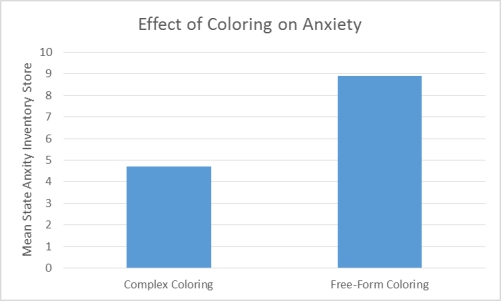Use the following to answer questions
Scenario I
Scenario I is based on fabricated data inspired by the following study:
Curry, N. A. & Kasser, T. (2005) . Can coloring mandalas reduce anxiety? Art Therapy: Journal of American Art Therapy Association, 22(2) 81-85.
Effect of Coloring on Anxiety
Curry and Kasser were interested in examining whether coloring complex geometric patterns reduces anxiety. To that end, they induced anxiety in 84 undergraduate volunteers from their university. Following anxiety induction the participants were divided into two coloring conditions. To determine which condition each participant would be in the researchers put all of their names in a hat. The first name drawn was placed in group 1, the second name drawn was placed in group 2, the third name drawn was placed in group 1, and so on. Those in the complex geometric coloring condition (group 1) were given a paper with a plaid pattern or the outline of a mandala. Those in the control condition (group 2) were given a blank piece of paper. After 20 minutes of coloring all of the participants completed a self-administered State Anxiety Inventory (SAI) . Lower SAI scores indicate low levels of anxiety whereas higher SAI scores indicate high levels of anxiety. The mean SAI scores of each coloring condition were compared to determine whether the type of coloring one does affects anxiety. The results revealed that those who colored a complex geometric pattern had significantly different levels of anxiety than those who colored on a blank sheet of paper. Curry and Kasser concluded that coloring causes a change in anxiety, but only when coloring requires a certain amount of attention and focus.
Figure 1. Effect of Coloring on Anxiety

-(Scenario I) In this study, the experimental group did NOT:
Definitions:
Employee Assistance Programs
Programs offered by employers to help employees deal with personal problems that might adversely impact their job performance, health, and well-being.
Sources of Stress
Various factors or situations that can cause mental or emotional strain and tension in individuals.
Manage the Stress
The practice of employing techniques and strategies to regulate and mitigate stress levels for the purpose of improving one's overall well-being.
Consequences
The outcomes or results that naturally follow from a specific action or set of conditions, either positive or negative.
Q1: For which of the following would an
Q25: Dr. Schubert noted the following results: F(2,
Q50: Katherine is interested in designing an experiment
Q65: If you wanted to determine if the
Q81: A 2010 study investigating whether darkness increases
Q97: Main effect hypotheses focus on the effect
Q118: Dr. Keefer is skeptical of using laboratory
Q127: When discussing a psychological experiment mundane realism
Q151: To experimentally test the adage "An apple
Q152: Which of the following would NOT be